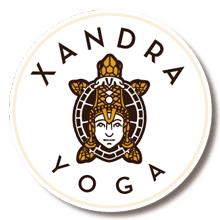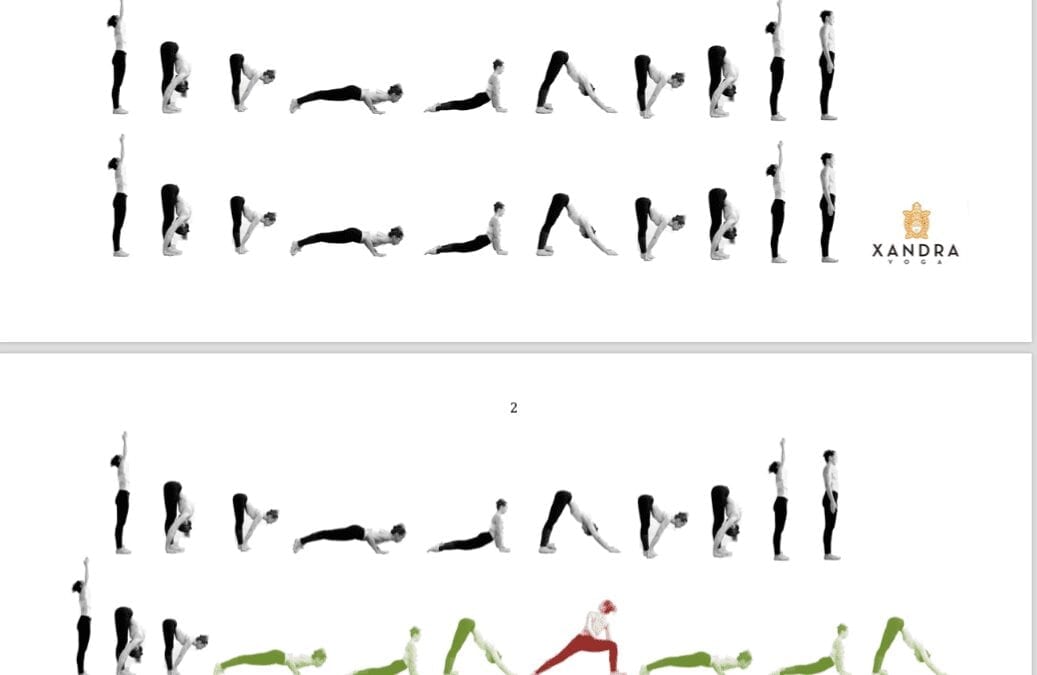If you want to download directly the Intermediate Vinyasa Yoga Class, please go down and choose the button « download ».
This module has been designed as « intermediate », however you will notice that there is absolutely no handstand, complicate asana such as bringing the foot behind the head, no deep backbends.
There is no need of tricky asana to be claimed such as « intermediate ».
The « vinyasa » are in green, the asana are in red. You can keep the asana for 5 to 7 breathes, in the case you decide to hold them for 7 breathes, you might need to shorten the class.
The 3 connective poses from one asana to another one are « Chaturanga, Urdhva Muka and Adho Muka« .
After Shirshana, before going to Shavasana, there is one full Vinyasa.
Why is this called as « Intermediate » ?
The goal is to develop the stamina through the breathing. Without breathing there is no movement, each asana has its own breathing.
Each inhalation are guiding the body up while the exhalation generally bring the body down.
When the asana is « done », after 5 breath, we leave the posture with one inhalation.
How to count the breathing
Once you are « IN » the asana
- Inhale, exhale
- Inhale, exhale
- Inhale, exhale
- Inhale, exhale
- Inhale, exhale
How to come in and out?
Each asana has its own Vinyasa.
For instance, Parshvakonasana :
1st Vinyasa (Going IN the asana) :
° Inhalation – From Adho Mukha Svanasana, place the right foot front, between the two hands, left foot 45°.
2nd Vinyasa (settle DOWN the asana)
° Exhalation – Fold the right leg 45°, place the right arm onto the right thigh. Roll the left arm behind the back and grab the right inner thigh, twisting the torso.
Only from here, the 5 breathings are starting.
3rd Vinyasa (dismounting the asana)
° Inhalation – Bring the 2 feet together, hips width distance, plank pose.
The asana is done, still you are with the inhalation, then:
° Exhalation, Chaturanga Dandasana,
° Inhalation, Urdhva Muka Svanasana
° Exhalation, Adho Muka Shavanasana.
Repeat the same thing for the other side.
The all process, moving in, moving out, is happening BECAUSE of the breathing, through the breathing you are moving. Drishtis will come later. Try to breathe naturally from the nostrils.
Do not think on how you are doing the asana, do not be in competition with yourself, just breathe.
Ujjayi breathing is not mandatory, try to take long inhalation and long exhalation.
As soon as you move from one asana to another one, do it with the breathing.
Asana Names
The practice starts with 5 Suraya Namaskara A
- Variation Parshvakonasana
- Trikonasana A
- Trikonasana B
- Anjanyeyasana
- Prasarita Padotanasana D
- Prasarita Padotanasana A
- Vrikshasana
- Uttitha Hasta Padanghustasana A
- Uttitha Hasta Padanghustasana B
- Virabhadrasana II
- Dandasana
- Parivritta Paschimotanasana
- Arhda Badda Pada Padma Paschimotanasana
- Janu Shirshasana A
- Trianga Mukha Eka Pada Paschimotanasana
- Eka Pada Malasana
- Gomukasana
- Bharavadjasana
- Navasana
- Bhujapidasana
- Kurmasana
- Bhujangasana
- Dhanurasana
- Bekasana variation
- Supta Padangustasana
- Purna Sethu Bandasana
- Chakrasana
- Sarvangasana – 9 breathings
- Halasana – 9 breathings
- Karnapidasana – 9 breathings
- Matshyasana – 9 breathings
- Uttana Padasana – 9 breathings
- Shirshasana – 15 to 25 breathings
- Balasana (5 to 10 breathings)
- Padmasana (5 à 10 breathings)
- Shavasana (10 minutes)
- Sidhasana and pranayama practice (20 minutes)
Pranayamas Practice
° Nadi Shodana for 10 minutes
° Bhastrika (with or without arms activation) 3 rounds of 2 minutes each
° Bhramari for 5 minutes
Please note that the only thing that will be making a difference between a stretching class or fitness is the importance you will give to your breathing.
The music should be the sound of your breathing, of your muscles, of your heart beat, the movement of your diaphragm.
Transform your practice into something very organic and do not compete with yourself.
Let the asana DNA imprint your body.
Namaste!


